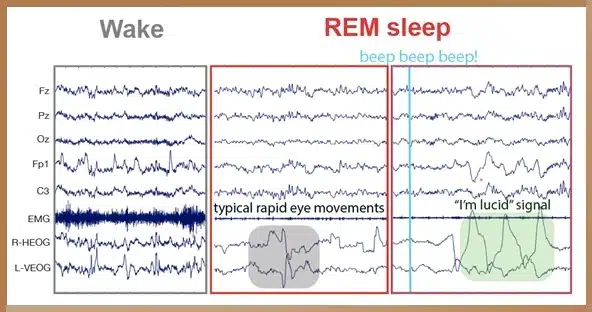
23 Jun Lucid Dreaming: Take Conscious Control of Your Dreams
Lucid dreaming, where we are aware that we are dreaming and can even exert some control over what happens in the dream, provides a unique opportunity to explore our subconscious mind or even enhance creativity. This article discusses its importance, its connection to spiritual life, its benefits and risks, a new study, and practical advice for those who want to master this special skill.
Even Plato believed that during sleep the rational part of the soul goes to sleep, so that the desiring part works more freely, and it is these desires that we suppress during our waking hours.
His disciple, Aristotle, describes dreams as a continuation of perception, a consequence of our experiences and impressions during the day that are processed by our minds at night.
In Tibetan Buddhism, the practice of dream yoga combines meditation and various yoga techniques to refine and purify the mind and gain insight into the nature of consciousness and the illusory nature of reality.

In shamanic traditions, lucid dreams are a kind of bridge between the spiritual world and reality, often using a variety of plants for deep spiritual and visual experiences. In this altered state of consciousness, shamans can channel healing energies and treat the souls of the sick.
One of the visionaries, Rudolf Steiner, the father of Anthroposophy, believed that sleep is not only for sustaining life force, but it can also help us grow spiritually and think differently about spirituality and ourselves through lucid dreaming.
While ancient wisdom offers a spiritual perspective, modern science is showing us more and more that lucid dreaming is not just a strange thing, but a skill that can be studied and developed. Freud was the first to suggest that our dreams might have meaning, and since then they’ve been the focus of neuropsychology and neuroscience.
The Meaning of Normal and Lucid Dreams
We spend a significant portion of our lives asleep, and dreaming is an essential aspect of that time, even if we don’t always realize it. Dreaming helps us process information, store memories, and may even have psychotherapeutic benefits.
And yet, despite the fact that we dream every night, most dreams are forgotten when we wake up. Given that so much of our lives are spent sleeping and dreaming, it is worth making the effort to be more aware and conscious during these moments when life force is being restored.
During REM (Rapid Eye Movement) sleep, our brains are as active as when we’re awake, but our muscles are temporarily paralyzed to prevent us from acting out our vivid dreams. As the night progresses, we enter REM sleep more frequently and for longer periods of time, increasing the likelihood of experiencing lucid dreams.

Lucid dreaming, where we become aware that we are dreaming and can even exert some control over the dream, provides a unique opportunity to explore our subconscious minds. Interestingly, our dream narratives, which are mostly emotionally driven, don’t really show our ability to organize our thoughts.
That’s because the part of the brain responsible for logical thinking is less active when we dream. As a result, dreams often seem vague, unusual, and fragmented. Yet in their apparent chaos, they can contain important messages and insights about our inner lives.
Take Dreams to a Higher Level!
The Egely Wheel is the Universal Life Energy Meter, an easy and fun way to harness your life energy.
Explore and see how unlocking your energy flow can lead to a higher state of awareness and control in your dreams.
How Lucid Dreaming Can Enrich or Endanger Your Spiritual Journey
While there are still many unanswered questions about the practice of conscious dreaming, there is no doubt that it offers a unique opportunity for an inner journey. Sean McNamara, author of Renegade Mystic: The Pursuit of Spiritual Freedom Through Consciousness Exploration and Renegade Mystic’s Concise Instructions for Lucid Dreaming and the Out of Body Experience, asserts that it has various benefits.
- Access Your Subconscious Mind: Learn more about your subconscious thoughts and desires. There’s a different kind of depth when you take a closer look at your own minds and observe what’s going on there.
- Reprogram your Psychological Wiring: Transform the way you think and feel. The desired result will be a mindset free of limiting beliefs.
- Face Your Fears: Overcome your fears and get rid of those nightmares. Recognize the dream and remove yourself from its negative influence.
- Spiritual Practice: Think of lucid dreaming as a kind of spiritual practice to achieve a higher spiritual vision.
- Experience the Impossible: Why not try to do things you can’t do in real life, like fly or talk to historical figures? Dream big, experiment with new ideas, and challenge yourself to step out of your comfort zone.
- Source of Inspiration: Use lucid dreaming as a source of inspiration, and you might even achieve breakthroughs if you’re a creative professional. It’s a space where you can do anything.
However, it is important to be aware of the potential risks as well.
- It requires significant mental effort, which can negatively impact the quality of your sleep – a critical factor in maintaining high life energy levels.
- If you suffer from certain mental disorders, such as schizophrenia, you should refrain from practicing conscious control over your dreams, because hallucinations can easily be mistaken for lucid dreams, which can even make your symptoms worse.
- Know what you’re trying to achieve. If you’re mentally stable and just curious, go for it. However, if you’re dealing with deeper difficulties, it’s probably not a good idea.
- Make sure you don’t get too caught up in this world and forget about real life. As Albus Dumbledore said, “It does not do to dwell on dreams and forget to live.“
TOP TIP
Learn about Lucid Dreaming from an Expert!

If you have decided that you would like to learn how to consciously control your dream and make it a part of your life, we would like to offer you the online video course by Sean Mcnamara, one of our excellent and renowned Spiritual Makers.
About Sean McNamara
- Clinical mental health counselor (MA, Regis University, Denver) (GoldenMeanCounseling.com)
- Psychedelic instructor (PathOfTheGoldenTeacher.com)
- Meditation instructor
- Consciousness researcher
- Psychic abilities (like telepathy and clairvoyance) instructor (MindPossible.com)
In the training, Sean McNamara will walk you through the process of mastering lucid dreaming and out-of-body experiences, step by step, with videos and practical steps to help you along the way.
The training is 100% online, so you can progress and process the material at your own pace. The key is consistency—that’s what it takes to have a successful experience and be able to enter conscious sleep on a regular basis.
What can you expect from the course? Here’s a sneak peek:
- Mnemonic Induced Lucid Dreaming (MILD)
- The “Wake, Back to Bed” (WBTB) Technique for Lucid Dreaming
- Presence Practice, also known as “Am I Dreaming?” Meditation
- Dream Yoga
- Guided “Wake Initiated Lucid Dreaming” (WILD) Trance
- Using Herbs and Supplements
- Converting a Lucid Dream into an Out-of-Body Experience
…and many, many more.
The New Way to Study Lucid Dreams
Lucid dreaming is a very exciting phenomenon, and there are still many questions to be answered, to which researchers from the Sleep Laboratory of the Faculty of Education and Psychology at ELTE (Eötvös Loránd University) are actively contributing.
Researchers Tamás Bogdány and Péter Simon, together with Philippe Peigneux from the Université libre de Bruxelles, published an article in the journal PNAS in 2022, providing very interesting information and observations for studying brain function.
Their article gives a brief overview of predictive coding, which originated in computer science but is now being used by neuroscientists to study dreams.
The purpose of their research is to better understand the nature of nightmares, strange dream experiences (such as levitation, flying, out-of-body experiences), the human brain, subjective reality, and the treatment of insomnia.
The idea of predictive coding is that the human brain compares what we experience now with what we experienced in the past. This helps us shape our experiences through our internal model, from how we process sensory information to how we make sense of it all. During sleep, we don’t get as many sensory inputs as we do when we’re awake, which is different from the vivid, complex, and detailed dream experiences we have.

For in dreams we enter a world that is entirely our own. Let them swim in the deepest ocean or glide over the highest cloud.
What are they talking about? It is well known that when we sleep, our bodies relax, our muscles rest, and we don’t receive as many sensory inputs. Now imagine that you’re running away from a lion, but you notice that your legs aren’t moving. In this case, your brain has two options:
- It makes you feel like something is keeping you from moving your legs, like leg irons or a swamp.
- It sends a stronger signal to move your legs until your body stops relaxing, which may cause you to suddenly kick and wake up.
This is how the brain works. It resolves the conflict between the command to move your legs (the intended command) and the sensory input (the legs are relaxed due to sleep). Using the same analogy, advanced lucid dreamers resolve this conflict by imagining the lion behind a cage, which gives them a sense of security that allows us to play with these scenarios to improve our problem-solving skills.
Take Control of Your Dreams with the Power of Logic
Have you ever thought that controlling your dreams can be a great way to gain deeper spiritual insight, connect with your subconscious, and better understand your inner self?
The reason is that this state is different from normal dreaming. You’re aware of what’s going on while you’re still asleep, which gives you the opportunity to achieve a higher spiritual vision.
For further exploration of consciousness and energy, learn more about the innovative Egely Wheel, a device designed to measure and enhance personal energy fields.
By mastering lucid dreaming, you can bring the power of thought into your dreams, reducing the overall “chaos” of dreaming. The result will be a higher state of consciousness, and thus a higher quality of life which is the general idea behind Anthroposophy.
Hopefully, this article will inspire you to begin the exciting journey of discovering the realm of vivid, lucid dreams, because developing consciousness is one of the most enriching things you can do in life.
10 Sources +
Egely Wheel has strict sourcing guidelines and relies on peer-reviewed studies, academic research institutions, and medical associations. We avoid using tertiary references.
- Lucid Dreaming and Out-of-Body Experience Course – https://mindpossible.thinkific.com/
- Can Learning to Lucid Dream Promote Personal Growth? – https://www.psychologytoday.com/
- Frequent lucid dreaming associated with increased functional connectivity between frontopolar cortex and temporoparietal association areas – https://www.nature.com/
- Can lucid dreaming help us understand consciousness? – https://www.theguardian.com/
- The Dream of God: How Do Religion and Science See Lucid Dreaming and Other Conscious States During Sleep? – https://www.frontiersin.org/
- Impact of Sleep and Brain Science of Lucid Dreaming: Insights into Therapeutic Applications – https://athenaeumpub.com/
- Self-perceived effects of lucid dreaming on men-tal and physical health – https://journals.ub.uni-heidelberg.de/
- A TUDATOS ÁLMODÁS TUDOMÁNYA – https://www.elte.hu/
- Lucid Dreaming: Definition, Techniques, Uses – https://www.verywellmind.com/
- Lucid Dreaming vs. Dream Yoga: What’s the Difference? – https://www.andrewholecek.com/

